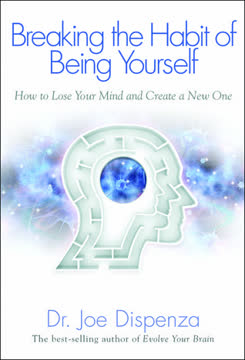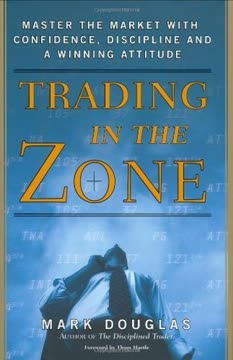Key Takeaways
1. Visual analysis simplifies market trends and outperforms traditional methods
The pictures tell us what a market is actually doing. They tell us whether a market is going up or down. That's all that really matters.
Simplicity is key. Visual analysis strips away the complexity of traditional market analysis, focusing on the most critical factor: price direction. By observing price trends through charts, investors can quickly identify whether a market is rising or falling, without getting bogged down in complex economic theories or conflicting expert opinions.
Universal application. The beauty of visual analysis lies in its versatility. These tools can be applied to any financial market worldwide, from stocks and bonds to commodities and currencies. This universality gives visual investors a significant advantage over those relying solely on fundamental or economic analysis, which often requires specialized knowledge for each market.
Leading indicator. Visual analysis excels at identifying trends before they become widely recognized. While economic reports and company fundamentals often lag behind market movements, price charts can reveal emerging trends months in advance. This forward-looking aspect of visual analysis allows investors to position themselves ahead of major market shifts, potentially leading to superior returns.
2. Price trends reveal market fundamentals more effectively than expert opinions
If the price of a market is rising, chances are good that its fundamentals are bullish. If the price is falling, the fundamentals probably aren't very good.
Market wisdom. Price trends reflect the collective wisdom of all market participants, incorporating all known information about a market. This aggregated knowledge is often more accurate and timely than individual expert opinions, which can be biased or based on incomplete information.
Avoiding analytical pitfalls. Relying on price trends helps investors avoid common analytical mistakes:
- Confirmation bias: Seeking information that supports pre-existing beliefs
- Anchoring: Placing too much importance on a single piece of information
- Overconfidence: Overestimating the accuracy of one's own predictions
Simplifying complex information. Price trends distill complex market dynamics into a clear, actionable signal. Instead of analyzing countless economic indicators or company metrics, investors can focus on the ultimate result of all these factors: the direction of price movement.
3. Relative strength analysis is crucial for identifying profitable sectors and assets
The relative strength line is the single most valuable tool in the asset allocation process.
Outperformance identification. Relative strength analysis compares the performance of different assets or sectors to a benchmark, typically the broader market. This comparison reveals which areas are outperforming or underperforming, guiding investors towards the most profitable opportunities.
Key applications of relative strength:
- Asset allocation: Determining optimal weightings between stocks, bonds, commodities, and currencies
- Sector rotation: Identifying leading and lagging sectors within the stock market
- Stock selection: Finding the strongest performers within a given industry or sector
Dynamic investing. Relative strength encourages a dynamic approach to investing, prompting investors to adjust their portfolios as market leadership changes. This adaptability can lead to better long-term performance compared to static allocation strategies.
4. Moving averages and oscillators provide essential trend confirmation and reversal signals
Moving averages, as helpful as they are, are lagging indicators. They confirm that a trend change has occurred, but only after the fact.
Trend following with moving averages. Moving averages smooth out price data to reveal underlying trends. They excel at:
- Defining the overall trend direction
- Identifying potential support and resistance levels
- Generating buy and sell signals through crossovers
Anticipating reversals with oscillators. Oscillators complement moving averages by providing early warning signals of potential trend changes:
- Overbought/oversold conditions: Indicating when a market has moved too far in one direction
- Divergences: Revealing when price and momentum are no longer in sync
- Centerline crossovers: Offering additional trend confirmation
Combining indicators. The most effective approach often involves using both moving averages and oscillators. This combination provides a more complete picture of market dynamics, balancing trend-following and reversal-anticipating signals.
5. Market breadth indicators offer early warnings of major market shifts
Market breadth indicators are especially important at spotting market tops and bottoms. Their value lines in the fact that they generally change direction before the major market indexes.
Looking beneath the surface. Market breadth indicators reveal the health of a market by measuring the participation of individual stocks or sectors. This provides a more comprehensive view than simply looking at major market indexes, which can be skewed by a few large-cap stocks.
Key breadth indicators:
- Advance-Decline Line: Tracks the number of advancing vs. declining stocks
- Percentage of Stocks Above Moving Averages: Measures overall market strength
- New Highs vs. New Lows: Identifies expanding or contracting market leadership
Early warning system. Breadth indicators often diverge from price action before major market turns. A weakening breadth amid rising prices can signal an impending top, while improving breadth in a falling market may foreshadow a bottom.
6. Intermarket analysis reveals crucial relationships between various asset classes
Intermarket analysis blurs the line between those two disciplines even further.
Holistic market view. Intermarket analysis examines relationships between different asset classes, such as stocks, bonds, commodities, and currencies. This broader perspective helps investors understand how changes in one market can impact others.
Key intermarket relationships:
- Stocks and bonds: Often move inversely, especially during economic uncertainty
- Commodities and the U.S. dollar: Typically have an inverse relationship
- Interest rates and gold: Rising rates often pressure gold prices
Global interconnectedness. In today's interconnected financial markets, understanding these relationships is crucial for making informed investment decisions. Intermarket analysis helps investors anticipate potential ripple effects across asset classes and geographic regions.
7. Exchange-traded funds (ETFs) revolutionize implementation of investment strategies
Exchange-traded funds (ETFs) have greatly simplified sector trading.
Versatility and accessibility. ETFs offer investors easy access to a wide range of markets and strategies:
- Broad market exposure
- Sector and industry-specific investments
- International and emerging markets
- Commodities and currencies
- Inverse and leveraged positions
Advantages over mutual funds:
- Intraday trading
- Lower expenses
- Greater tax efficiency
- Transparency of holdings
Strategy implementation. ETFs enable investors to quickly and efficiently implement various investment strategies, such as sector rotation, asset allocation shifts, and hedging, with minimal transaction costs and maximum flexibility.
8. Sector rotation strategies can significantly enhance portfolio performance
Being in the right sectors (and out of the wrong ones) is very important.
Capitalizing on market cycles. Different sectors of the economy tend to outperform at various stages of the business cycle. By understanding these patterns and using visual analysis to identify sector trends, investors can potentially enhance their returns.
Key sector rotation principles:
- Overweight strong sectors, underweight weak sectors
- Use relative strength analysis to identify sector leadership
- Monitor sector trends regularly, as they can change more frequently than broad market trends
Implementation tools. Sector ETFs and mutual funds provide efficient vehicles for implementing rotation strategies, allowing investors to quickly adjust their sector exposure as market conditions change.
9. Chart patterns and support/resistance levels guide entry and exit points
The best buy signals are given when both the daily and weekly lines are turning up from below 30.
Visual roadmap. Chart patterns and support/resistance levels provide a visual roadmap for potential price movements, helping investors identify optimal entry and exit points.
Common chart patterns:
- Double tops/bottoms
- Head and shoulders
- Triangles
- Flags and pennants
Support and resistance. These levels represent areas where buying or selling pressure has previously halted price movements. They often act as turning points for future price action, making them valuable for setting stop-loss orders and profit targets.
10. Volume analysis confirms price movements and trend strength
Generally speaking, when a stock price is in an uptrend, buying pressure should be greater than selling pressure.
Validation tool. Volume provides crucial confirmation of price movements, helping to distinguish between significant trends and potential false breakouts.
Volume principles:
- Rising volume in the direction of the trend confirms its strength
- Declining volume during a price move may signal a weakening trend
- Volume spikes often occur at major turning points
On-balance volume (OBV). This indicator provides a cumulative measure of volume flow, helping investors identify potential divergences between price and volume trends. Such divergences can offer early warnings of impending trend reversals.
Last updated:
FAQ
What's "The Visual Investor: How to Spot Market Trends" about?
- Overview: "The Visual Investor" by John J. Murphy is a guide to using visual analysis to identify market trends across various financial markets, including stocks, bonds, commodities, and currencies.
- Purpose: The book aims to simplify the process of market analysis by focusing on visual tools and techniques that can be applied universally to any market.
- Audience: It is designed for both novice and experienced investors who want to enhance their market analysis skills using charts and visual indicators.
- Content: The book covers a range of topics, including trend identification, market indicators, intermarket analysis, and the use of mutual funds and exchange-traded funds (ETFs).
Why should I read "The Visual Investor"?
- Simplified Approach: The book offers a straightforward approach to market analysis, making it accessible to those who may find traditional technical analysis intimidating.
- Comprehensive Coverage: It covers a wide array of financial markets and provides tools that can be applied to both short-term trading and long-term investing.
- Practical Tools: Readers will gain practical skills in using charts and indicators to make informed investment decisions.
- Author Expertise: John J. Murphy is a well-respected figure in the field of technical analysis, bringing credibility and depth to the subject matter.
What are the key takeaways of "The Visual Investor"?
- Visual Analysis: Emphasizes the importance of using visual tools like charts to understand market trends and make investment decisions.
- Trend Identification: Provides methods for identifying market trends and understanding their implications for different asset classes.
- Intermarket Relationships: Explains how different financial markets are interconnected and how these relationships can be used to predict market movements.
- Sector and Asset Allocation: Offers strategies for sector rotation and asset allocation to optimize investment portfolios.
How does John J. Murphy define "Visual Investing"?
- Definition: Visual investing is the use of charts and visual tools to analyze market trends and make investment decisions.
- Purpose: It aims to simplify the investment process by focusing on what the market is actually doing, rather than relying solely on fundamental analysis.
- Tools: Utilizes charts, trendlines, moving averages, and other visual indicators to assess market conditions.
- Benefits: Helps investors quickly identify market trends and make informed decisions without getting bogged down by complex data.
What are the most important visual tools discussed in "The Visual Investor"?
- Trendlines: Used to determine the slope of a market trend and identify potential support and resistance levels.
- Moving Averages: Help confirm trend direction and signal potential trend changes.
- Relative Strength Index (RSI): Measures overbought and oversold conditions to anticipate market reversals.
- MACD Indicator: Combines moving averages to provide both trend-following and overbought/oversold signals.
How does "The Visual Investor" explain the concept of market linkage?
- Intermarket Analysis: The book emphasizes the importance of understanding how different financial markets are interconnected.
- Asset Classes: Discusses the relationships between stocks, bonds, commodities, and currencies, and how they influence each other.
- Practical Application: Provides strategies for using these linkages to make informed asset allocation decisions.
- Examples: Uses historical examples to illustrate how market linkages can predict future market movements.
What is the role of sector analysis in "The Visual Investor"?
- Sector Rotation: The book explains how to identify which market sectors are leading or lagging and how to adjust investments accordingly.
- Performance Charts: Utilizes performance charts and sector carpets to visually assess sector strength and weakness.
- Economic Indicators: Links sector performance to stages in the business cycle, providing insights into economic conditions.
- Investment Strategy: Encourages focusing on strong sectors while avoiding weaker ones to enhance portfolio performance.
How does "The Visual Investor" address the use of mutual funds and ETFs?
- Mutual Funds: Discusses how to use visual analysis to select mutual funds that align with market trends and personal investment goals.
- ETFs: Highlights the advantages of ETFs for active trading and sector rotation due to their flexibility and lower costs.
- Comparison: Compares mutual funds and ETFs, explaining when each is most appropriate for different investment strategies.
- Practical Tips: Offers guidance on using visual tools to analyze and select the best funds for a given market environment.
What are the best quotes from "The Visual Investor" and what do they mean?
- "The market is always right." This quote emphasizes the importance of trusting market trends over personal biases or external opinions.
- "It's all about trend." Highlights the central theme of the book, which is the significance of identifying and following market trends.
- "Visual analysis is the best way to determine that." Reinforces the book's focus on using visual tools to make informed investment decisions.
- "Keep it simple." Encourages investors to focus on straightforward, effective strategies rather than getting overwhelmed by complex data.
How does "The Visual Investor" suggest handling market volatility?
- Bollinger Bands: Recommends using Bollinger Bands to measure market volatility and identify potential price extremes.
- ADX Line: Suggests using the Average Directional Movement (ADX) line to determine whether a market is trending or in a trading range.
- Risk Management: Emphasizes the importance of using visual tools to manage risk and make informed decisions during volatile periods.
- Diversification: Advises diversifying investments across different asset classes and sectors to mitigate the impact of volatility.
What is the significance of the MACD indicator in "The Visual Investor"?
- Trend-Following: The MACD indicator is used to identify the direction of a market trend and confirm trend changes.
- Oscillator Function: It also functions as an oscillator, providing overbought and oversold signals to anticipate market reversals.
- Histogram: The MACD histogram offers early warnings of potential trend changes by measuring the difference between the MACD line and the signal line.
- Versatility: The MACD is highlighted as a versatile tool that combines the best features of moving averages and oscillators.
How does "The Visual Investor" recommend using relative strength analysis?
- Asset Comparison: Relative strength analysis is used to compare the performance of different asset classes, sectors, and individual stocks.
- Sector Rotation: Helps identify which sectors are outperforming or underperforming the market, guiding investment decisions.
- Stock Selection: Assists in selecting the strongest stocks within a leading sector to maximize investment returns.
- Global Markets: Applies relative strength analysis to international markets to identify opportunities for global diversification.
Review Summary
The Visual Investor receives mostly positive reviews, with readers praising its clear explanations of technical analysis and charting concepts. Many find it helpful for beginners, offering valuable insights into reading charts and understanding market indicators. Some readers note that the book is slightly outdated and could benefit from color graphs. Despite this, it's generally considered a good introduction to technical analysis, with practical examples and a well-structured approach. Readers appreciate the author's ability to simplify complex concepts and provide useful trading tips.
Similar Books










Download PDF
Download EPUB
.epub digital book format is ideal for reading ebooks on phones, tablets, and e-readers.







